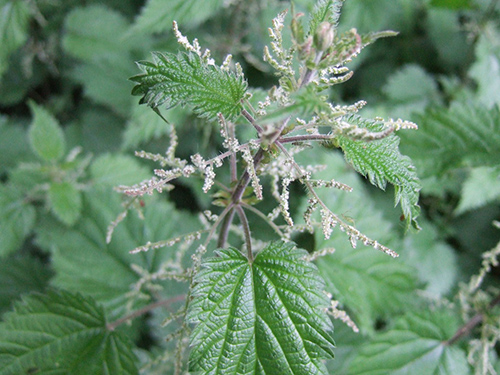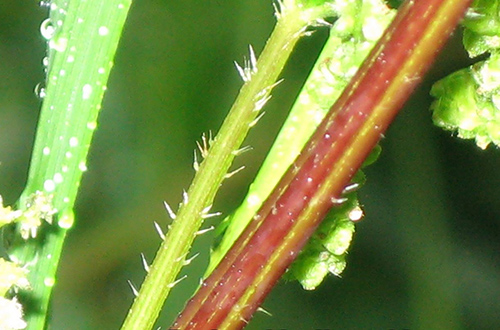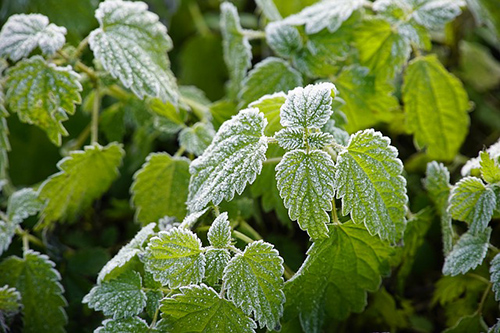It’s too bad that so many people avoid nettle. Unfortunately, many see it as a weed and know nothing of the many stinging nettle benefits. If they only knew how many virtues this allegedly aggressive plant keeps! Nettle is one of the superstars of phytotherapy. Its unusual hairs make it known, even by blind people; thus, one of its nicknames is the herb of the blind.
The Greek physician Dioscorides already praised it in the first century A.D., and his Spanish translator, Andres de Laguna, a Spanish physician of the sixteenth century, says about the nettle leaves, among other things, that
“They may excite people towards lust.”
How could these stinging leaves excite sexual appetite? French herbalist Messegue states that the Latin poet of the first century A.D., Caius Petronius, recommended that men who wanted to increase their virility be whipped “with a bunch of nettles on their lower stomach and their buttocks.” Ancient Greeks practiced urtication or rubbing with fresh nettles.
Besides stinging nettle benefits sexuality, it renders excellent results to people suffering from rheumatism and arthrosis who have the guts to perform it. This plant also helps increase testosterone.
How to use Stinging Nettle

To calm those who are afraid of this plant, after 12 hours of being gathered, its stinging effect disappears, and the plant acquires a velvet-like touch.
- The best way to take advantage of its medicinal properties, especially its depurative effect, is via FRESH JUICE. You can achieve this by pressing its leaves or putting it in a blender. Drink half to one glass in the morning and another in the afternoon.
- INFUSION with 50 g per liter of water, steeping for 15 minutes. This process is how to make nettle tea. Drink 3 or 4 cups daily.
- Make a stinging nettle cream by applying the juice to the affected area.
- Stinging nettle treatment uses compresses soaked in the juice and applied to the affected area. Change them three or four times a day.
- Nose plugging. Soak a gauze in the nettle juice, then plug it into the nostrils
Stinging Nettle Scientific Facts
- Synonyms. Common nettle, common stinging nettle, great stinging nettle, stinging nettle.
- French. Ortie.
- Spanish. Ortiga mayor
- Habitat. Growing worldwide, the plant prefers humid places close to populated areas.
- Description. The Urticaceae family’s Vivacious plant grows from 0.5 to 1.5 meters high. Stinging hairs cover both the stems, square-shaped, and leaves. Its green-colored flowers are very small.
- Parts used. The whole plant, especially its leaves.
A Good Food
You can consume nettle raw in salads, omelets, soups, or boiled like any other vegetable. It is an even tastier substitute for spinach because it is less sour. Nettles are a great source of proteins: when fresh, they contain 6 to 8 grams per 100 g, and when dried, they contain 30 to 35 g (a similar percentage to that of soya, one of the legumes with a higher amount of proteins).
Stinging Nettle Benefits

The hairs of the nettle contain histamine and acetylcholine. Our bodies also produce these substances, and they take an active part in the circulatory and digestive systems as transmitters of the nervous pulses of the autonomic nervous system. Some ten milligrams of these substances are enough to provoke a skin reaction.
The leaves contain plenty of chlorophyll, the green coloring of the vegetal world. Their chemical composition is very similar to hemoglobin, which red-colors our blood. They are rich in mineral salts, especially iron, phosphorus, magnesium, calcium, and silicon, which makes them diuretic and depurative.
The leaves also contain vitamins A, C, and K, formic acid, tannin, and other substances not yet studied. The compound of these substances makes the nettle one of the plants with the most medicinal applications.

Depurative, diuretic, and alkalizing
Recommended for rheumatic afflictions, gout, arthritis, kidney stones, urinary sand, and as a rule, whenever a depurative and diuretic action is required. The nettle has a notable ability to alkalinize the blood, easing the expulsion of metabolic acid waste related to all these afflictions. The internal use of the plant can be combined with urtications on the affected joint.
Antianemic
It is used in anemia caused by lack of iron or by loss of blood. The iron and the chlorophyll that the nettle contains stimulate the production of red blood cells. The nettle also suits recovery, malnutrition, and exhaustion cases due to its stimulating and recovering effects.
Vasoconstrictor and hemostatic
Nettle is especially recommended for uterine and nasal bleeding. It is beneficial for women with excessive menstruation. We have to insist that a physician must check out any abnormal bleeding.
Digestive
It renders good results in digestive disorders caused by atony or insufficiency of digestive organs. Nettles contain small amounts of secretin, a hormone produced by certain glands of our intestines that stimulates the secretion of pancreatic juices and the gall bladder. This explains why nettle eases digestion and improves food assimilation.
Astringent
It has been successfully used to calm intense diarrhea caused by cholera. Nettles are helpful in all types of diarrhea, colitis, or dysentery.
Hypoglycemic
Nettle leaves decrease blood sugar levels, which has been checked out in many patients. Though they cannot substitute insulin, they allow a decrease in the dosage of antidiabetic medicine.
Galactogene
It increases the milk secretion of breastfeeding women, thus being recommended while breastfeeding.
Emollient
Due to its soothing effect, it is recommended for chronic skin afflictions, especially eczema, eruptions, and acne. It is also used for hair loss. Nettles clean, regenerate, and make skin more beautiful. Better results are achieved if employed orally, in addition to in local applications.
Urticating
With a freshly gathered bunch of nettles, gently hit the skin of the joint affected by the inflammatory or rheumatic disorder (knee, shoulder, etc.). A revulsive effect occurs, attracting blood to the skin and decongesting the internal tissues.
DISCLAIMER: All content on this website is presented solely for educational and informational objectives. You should not rely on the information provided as a replacement for advice, diagnosis, or treatment from a qualified medical expert. If you are pregnant, nursing, or have any preexisting medical concerns, you should talk to your doctor before using any herbal or natural medicines.
References
- George D. Pamplona-Roger, M.D. “Encyclopedia of Medicinal Plants.” George D. Pamplona-Roger, M.D. Encyclopedia of Medicinal Plants. Ed. Francesc X. Gelabert. vols. 1 San Fernando de Henares: Editorial Safeliz, 2000. 278, 279. Print. [Stinging nettle]
- General Information on Stinging Nettle:
- Mount Sinai – New York: https://www.mountsinai.org/health-library/herb/stinging-nettle
- WebMD: https://www.webmd.com/vitamins/ai/ingredientmono-664/stinging-nettle
- Healthline: https://www.healthline.com/nutrition/stinging-nettle
- Stinging Nettles: An Herbal Resource by Daniel R. Kolak
- The Complete Book of Herbal Medicine by Barbara Griggs
- Drugs and Supplements in Complementary and Alternative Medicine by Edzard Ernst
- Natural Medicines Comprehensive Database
- The Green Pharmacy by Barbara Griggs
- Journal of Ethnopharmacology: “Stinging nettles (Urtica dioica): A review of the herbal medicine”
